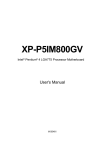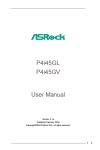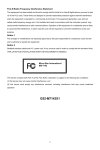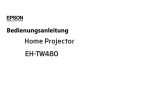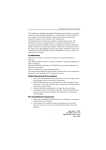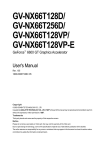Download XP-P5CM-GV/ XP-P5CM-GL
Transcript
XP-P5CM-GV/ XP-P5CM-GL Intel® Pentium® 4 LGA775 Processor Motherboard User's Manual M-050501 Copyright Declaration © 2005 Gigatrend Technology Co., Ltd. All rights reserved. No part of this manual may be reproduced, copied, translated, or transmitted in any form or by any means without express permission from Gigatrend Technology. Companies and product names mentioned in this document are trademarks or registered trademarks of their respective owners. Legal Disclaimer The information and content of this document is provided "as is", without warranty of any kind, express or implied, including but not limited to the warranties of merchantability, fitness for a particular purpose and non-infringement. Gigatrend Technology assumes no responsibility for errors or omissions in this document or other documents which are referenced by or linked to this document. The content of this document are subject to change without prior notice. Gigatrend Technology may make improvements and/or changes in the product described in this publication at any time and without prior notice. In no event shall Gigatrend Technology be liable for any special, incidental, indirect or consequential damages of any kind arising out of or in connection with the use or performance of this document. If you are uncertain about any installation procedures, please consult a qualified computer technician. Terms of Use To avoid unnecessary errors of operation, please consult the user manual prior to hardware installation. For more up-to-date information, please link to our company website at http:// www.axper.com.tw Prior to beginning installation procedures, please make sure that your computer turned off and is connected to a grounded power outlet. If your system is not turned off during installation, this could result in harm or damage to the motherboard, the components as well as to the user. Motherboard XP-P5CM-GV/XP-P5CM-GL Motherboard XP-P5CM-GV/XP-P5CM-GL May 25, 2005 May 25, 2005 Contents Motherboard Layout ......................................................................... 4 1. Product Introduction .................................................................. 5 1.1. Feature Summary ............................................................................. 5 1.2. I/O Back Panel and Connectors&Jumper Setting ........................... 6 1.2.1. I/O Back Panel ....................................................................................... 6 1.2.2. Connectors&Jumper Setting ................................................................ 6 2. Hardware Installation ............................................................... 10 2.1. Installation of a LGA775 Pentium 4 CPU and Fan Sink ................ 10 2.1.1. Installation of a LGA775 CPU ............................................................ 10 2.1.2. Installation of Fan Sink ....................................................................... 11 2.2. Installation of Memory..................................................................... 12 2.3. Installation of the Graphics Card ................................................... 13 2.4. What is Axper's G.E.A.R.? ............................................................... 13 2.4.1. Graphics Card Support List ............................................................... 13 3. BIOS Setup ............................................................................ 17 3.1. Setup Screen Features (BIOS version:F1) .................................... 17 3.2. Standard CMOS Features .............................................................. 18 3.3. Advanced BIOS Features ............................................................... 20 3.4. Integrated Peripherals .................................................................... 21 3.5. Power Management Setup ............................................................ 23 3.6. PnP/PCI Configuration ................................................................... 24 3.7. PC Health Status ............................................................................ 25 3.8. Frequency/Voltage Control ............................................................. 26 3.9. Load Fail-Safe Defaults ................................................................. 27 3.10. Load Optimized Defaults ................................................................ 27 3.11. Set User Password ........................................................................ 27 3.12. Save & Exit Setup ............................................................................ 27 3.13. Exit Without Saving.......................................................................... 27 4. Driver Installation ..................................................................... 28 IT8712F KB_MS CPU_FAN COM1 LGA775 FDD VGA LPT ATX_12V ATX Intel 915GV j/ Intel 915GLk SUR_CEN SYS_FAN DIMM1 IDE1 PCIE_16 DIMM2 AUDIO F_AUDIO XP-P5CM LAN USB R_USB BIOS RTL8100C PCI1 ICH6 GLk GEAR -GV j / English Motherboard Layout SATA2 SATA0 CODEC PCI2 CD_IN F_USB1 Only for XP-P5CM-GV. 4 Only for XP-P5CM-GL. BAT CLR_CMOS PWR_LED F_PANEL English 1. Product Introduction The user manual provides steps related to quick installation. If you wish to view complete ",open User Manual button located on the driver product information, please select the " CD or link to our website at http://www.axper.com to received the most up-to-date information. 1.1. Feature Summary CPU Chipset Memory Slots On-Board IDE On-Board Floppy On-Board SATA On-Board Peripherals On-Board LAN On-Board VGA On-Board Sound BIOS I/O Control Hardware Monitor Form Factor LGA775 for Intel® Pentium® 4 Processor Intel® Pentium® 4 533/800MHz FSB L2 cache depends on CPU North Bridge: Intel® 915GV /GL South Bridge: Intel ® ICH6 2 184-pin DDR DIMM sockets, supports up to 2GB DRAM (Max.) Supports dual channel DDR400/DDR333 DIMM Supports only 2.5V DDR SDRAM 1 PCI Express x 16 slot device support * 1 GEAR slot device support 2 PCI slots support 33MHz & PCI 2.2 compliant 1IDE controller provides IDE HDD/CD-ROM with PIO, Bus Master (Ultra DMA33/ATA66/ATA100) operation modes Can connect up to 2 IDE devices 1 Floppy port supports 2 FDD with 360K, 720K,1.2M, 1.44M and 2.88M bytes 2 Serial ATA ports 1 Parallel port supports Normal/EPP/ECP mode 1 Serial port (COM1), 1 VGA port 6 USB 2.0/1.1 ports (4 x Rear, 2 x Front by cable) 1 Front Audio connector 1 PS/2 Keyboard 1 PS/2 Mouse Built-in RTL8100C chip 1 RJ45 port Built-in Intel® 915GV /GL chipset ALC655 CODEC Supports 2/4/6 channel Line Out / Line In / Mic In CD In Licensed AWARD BIOS Supports BIOSNow! IT8712F CPU/System fan revolution detect CPU/System fan fail warning CPU temperature detect System voltage detect Micro ATX size form factor, 23.6cm x 24.3cm * PCI Express x 16 card runs up to x 4 mode Only for XP-P5CM-GV. Only for XP-P5CM-GL. 5 English 1.2. I/O Back Panel and Connectors&Jumper Setting 1.2.1. I/O Back Panel Parallel Port PS/2 Mouse LAN Line In USB Line Out MIC In PS/2 Keyboard COM1 PS/2 Keyboard PS/2 Mouse connector Parallel port (LPT) COM1 (Serial port) VGA port USB (Universal Serial Bus Port) LAN (RJ45 LAN Port) Line In Line Out MIC In 1.2.2. VGA USB Connects PS/2 standard keyboard and PS/2 standard mouse Connects to printer Connects to serial-based mouse or data processing devices Connects to 15-pin D-Sub device such as a monitor Prior to use, please make sure that your system as well as the connected attachments support the USB interface. If driver installation is required, please consult the USB section of the user manual. Internet connection with speed of up to10/100Mbps Connects to optical devices, CD players and other audio input devices Connects to speakers or headphones Connects to microphone Connectors&Jumper Setting FDD (Floppy Disk Drive Connector) The FDD connector is able to connect a single floppy disk drive via a FDD cable. Usually one edge of the FDD cable is marked in red, please attach this marked edge to position 1 on the connector. 2 34 1 33 IDE (IDE Connector) The IDE connector is able to connect two IDE devices via an IDE cable and requires checking of the IDE jumper setting. 6 2 40 1 39 The cooler fan power connector supplies a +12V power voltage via a 3-pin/4-pin(only for CPU_FAN) power connector and possesses a ful-proof connection design. Most coolers are designed with color-coded power connector wires. A red power connector wire indicates a positive connection and requires a +12V power voltage. The black connector wire is the ground wire (GND). Please remember to connect the power to the cooler to prevent system overheating and failure. Caution! Please remember to connect the power to the CPU fan to prevent CPU overheating and failure. PIN 1 1 CPU_FAN SYS_FAN SIGNAL 1 GND 2 +12V 3 4 Sense Speed Control (Only for CPU_FAN) ATX_12V (+12V Power Connector) The ATX_12V power connector provides power to the CPU. If this connector is not Attached, the system will not start. PIN SIGNAL 1 GND 3 4 2 GND 1 2 3 4 +12V +12V ATX (ATX Power Connector) The ATX power connector provides power to the motherboard. Prior to connection, please make sure that the power supply is disconnected. PIN 13 1 24 SIGNAL PIN SIGNAL 1 2 3.3V 3.3V 13 14 3.3V -12V 3 GND 15 GND 4 +5V 16 PS_ON (soft on/off) 5 6 GND +5V 17 18 GND GND 7 GND 19 GND 8 Power Good 20 -5V 9 10 5V SB (stand by +5V) +12V 21 22 +5V +5V 11 +12V 23 +5V 12 3.3V (only for 24-pin ATX) 24 GND 12 PWR_LED Connects to the system power LED indicator whereby the power is indicated as ON or OFF. However, the indicator will flash when the system is suspended. PIN 1 SIGNAL 1 2 MPD+ MPD- 3 MPD- 7 English CPU_FAN (CPU Fan Power Connector); SYS_FAN (System Fan Power Connector) SPK- SPK+ MSG+ MSGPW+ PW- The F_Panel Control Connector connects to certain connectors on the front panel of the system casing such as IDE Hard Disk Active LED, speaker, reset, and power on/off connectors. You can use the schematic diagram below as the basis for connection. 2 1 20 19 HD+ HDRESRES+ NC English F_PANEL (Front Panel Control Connector) PIN SIGNAL HD IDE Hard Disk Active LED SPK RES Speaker Connector Reset Switch PW Soft Power Connector MSG Message LED/Power/Sleep LED NC NC SATA0/SATA2 (Serial ATA Connector, controlled by ICH6) The SATA0/2 connector is able to connect a single Serial ATA device via a SATA cable. For the connected SATA hard disk to work correctly, please check the related BIOS setting and install proper driver for the SATA controller. PIN 1 1 7 SIGNAL GND 2 TXP 3 TXN 4 GND PIN SIGNAL 5 RXN 6 7 RXP GND F_AUDIO (Front Audio Connector) Connects to the audio connector located on the front panel of the system casing (dependent on case design). When use of the front panel audio connector is required, please remove the 5-6 pin, 9-10 pin jumper. Please note that use of only the front panel audio connector or the rear panel audio connector is permitted. PIN 10 9 2 1 SIGNAL 6 Rear Audio (R) 7 Reserved 3 MIC_BIAS 4 POWER 8 9 NO PIN Front Audio (L) 5 Front Audio (R) 10 Rear Audio (L) Connects CD-ROM or DVD-ROM audio connector. PIN 8 SIGNAL MIC GND CD_IN (Optical Drive Audio Connector) 1 PIN 1 2 SIGNAL 1 2 CD_L GND 3 GND 4 CD_R Connects to the USB connector located on the front panel of the system casing (dependent on case design). Note: Please make sure that each USB connection matches its designated position. If connections are made incorrectly, the result can lead to inability to use the function or even damage. PIN SIGNAL PIN SIGNAL 9 1 10 2 1 POWER 6 USB Dy+ 2 3 POWER USB Dx- 7 GND 4 USB Dy- 8 9 GND NO PIN 5 USB Dx+ 10 NC SUR_CEN (Surround Center Connector) Please contact the place of purchase for the optional SUR_CEN cable. PIN SIGNAL 6 5 1 2 SUR OUTL SUR OUTR 2 1 3 GND 4 No Pin 5 6 CENTER_OUT BASS_OUT CLR_CMOS (Clear CMOS) You can clear the motherboard CMOS with the jumper to return your system to its initial status. To prevent improper usage, the jumper does not include the jumper plug. If you wish to use the Clear CMOS function, please short circuit the 1-2 Pin. 1 Open : Normal 1 Short : Clear CMOS BAT(Battery) The improper removal of the battery can result in harm. When replacing a battery, please make sure you use one that is of similar brand and model number. For information related to battery specifications and precautions, please refer to the manufacturer instructions. If you wish to delete the data stored in the CMOS, please follow the steps below: 1. Please turn off your computer and unplug the power. 2. Remove the battery from the motherboard. 3. Wait 10 minutes and then replace the battery onto the motherboard. 4. Plug in the power supply and turn on your system. 9 English F_USB1 (Front USB Connector) English 2. Hardware Installation 1. Please make sure that the CPU used is supported by your motherboard. 2. Please be aware of the placement position of the CPU. If the CPU does not insert properly, do not apply force but check the placement position. 3. Please make sure that an even layer of heat sink paste is added between the CPU and the fan sink. 4. Please do not turn on the power prior to installing the fan sink. Doing so can result in overheating and lead to permanent damage to the CPU. 5. Please follow the CPU specifications when setting the frequency. It is not recommended that system speed settings exceed that of hardware specifications. If you wish to set your system speed to exceed the recom mended specifications, please check your hardware specifications eg: CPU, graphics card, memory, hard drive The following must be supported to allow the use of Hyper-Threading Technology: - an Intel Pentium 4 CPU with HT - a motherboard supporting HT - HT selection feature within BIOS - an operating system supporting HT 2.1. Installation of a LGA775 Pentium 4 CPU and Fan Sink 2.1.1. Installation of a LGA775 CPU 1. Push the socket lever arm down and away from the CPU socket and raise it up completely. 2. Open the load plate and gently remove the plastic cover. 3. Hold the CPU with your thumb and index fingers (do not touch the bottom of the CPU when holding it). Align notchs on the two sides of the CPU with the small sockets of the CPU socket and place the CPU straight down. 10 2.1.2. Installation of Fan Sink 1. Apply a thin coating of thermal paste to complete cover the surface of the CPU. 2. Align the four fasteners of the fan sink with the four holes around the CPU socket. Push down each fastener and you should hear a "click" when the fastener is attached. Make sure the four fasteners are attached securely. Prior to installation of the fan sink, check the direction of each fastener by the arrow engraved on fastener top. Before attaching the fasteners, turn each fastener clockwise. To uninstall the fan sink, release each fastener by rotating the fastener along the direction of the arrows and pull them up. 3. Connect the 4-wire power cable of the fan sink to the CPU_FAN header on the motherboard to complete the installation. 11 English 4. Make sure the CPU is properly installed and then close the load plate. Lower the socket lever and engage it to lock the CPU in place. English 2.2. Installation of Memory 1. Before installing or removing memory, please make sure that the computer power is turned off to prevent hardware damage. 2. Please make sure that the memory used is supported by the motherboard. 3. Memory modules have a foolproof insertion design. The memory can be in stalled only when facing the correct position. If you cannot insert the module, please switch directions. 4. It is recommended that memory of similar capacity, specifications and brand be used. The motherboard supports DIMM memory modules, whereby BIOS will automatically detect memory capacity and specifications. Memory modules are designed so that they can be inserted only in one direction. 1. Unfasten the clips on each end of the memory slots. Correctly align the memory module in the slot and push downwards.. 2. Once the memory module is correctly inserted, the clips will automatically refasten. If the memory module is positioned in the wrong direction, it will not insert. If this occurs, please switch directions. 12 Installation of the Graphics Card To install or remove an AGP graphics card, first pull out the white GEAR knob before insertion or removal. Releasing the GEAR knob will hold the graphics card firmly in place. 2.4. What is Axper's G.E.A.R.? The revolutionary and innovative G.E.A.R. (GIGABYTE Enhance AGP Riser) interface provides an additional interface for traditional AGP Graphics card on Intel chipset based PCI Express solution motherboard. It supports most of the AGP Graphics card available in the market from AGP 4X to AGP 8X graphics cards. Note the following Information Before Use 1) Remove the sticker on the G.E.A.R. slot before inserting your AGP graphics card. 2) G.E.A.R. interface is designed to provide a temporary AGP solution before the mass availability of PCI Express graphics card. It is suggested to use PCI Express X 16 interface graphics card to avoid the damage of your AGP graphics card. 3) G.E.A.R. interface is created through PCI interface signal and voltage switching to AGP interface, due to this technical specification difference, it might cause AGP graphics card life-span shortens. 4) Please view the graphics cards support list currently validated by Axper engineers. 2.4.1. Graphics Card Support List (The items below are all supported under the Windows XP operating system. When using an add-on graphics card, please first delete the onboard graphics driver before installing the driver for the add-on graphics card.) Figure 1-1. 4X AGP Card Graphics Chip Nvidia Maker Gigabyte Gigabyte Gigabyte Gigabyte Gigabyte Gigabyte Model Name GA-620 GA-622 GA-660 Plus GA-GF2560 GA-GF2000 GA-GF1280 To be continued... 13 English 2.3. 1. Before installing the graphics card, please carefully read the accompanying user manual. As well, make sure the computer power is turned off. 2. If you install a PCI Express x 16 card and wish to remove it, please gently press the latch to release the card as the picture below shows before removal. English Figure 1-2. 4X AGP Card Graphics Chip Nvidia ATi SiS Savage Maker Gigabyte Gigabyte Gigabyte Gigabyte Gigabyte Gigabyte ELSA ELSA ELSA ELSA Leadtek Leadtek Leadtek Gigabyte Gigabyte Gigabyte Gigabyte Gigabyte Gigabyte Prolink ASUS Model Name GV-GF2010D GA-GF3000D GV-GF1280-32E GV-GF1280T-32P GV-GF3200TF GV-GF3500TF-GH Gladiac Ultra Gladiac 517 Gladiac 517vivo Gladiac 525 A128 WinFast A170 TH WinFast A250 TO WinFast A250 Ultra GV-AR64DL-T-SI GV-AR64S-H GV-AP64D GV-AP64DH GV-AP128DG-H GV-AF128D-GH SiS315 64MB V3500 Maker Gigabyte Gigabyte ASUS ASUS ASUS MSI MSI Leadtek Leadtek Albatron Gigabyte Gigabyte Gigabyte Gigabyte Gigabyte Gigabyte Triplex Power Color Model Name GV-N57L128D GV-N59X128D V9180TD V9480-TVD V9520 MX440-VTD8X MS-8888 Ti4600-TD-8X WinFast A280LE TD WinFast A310 TD NVIDIA 5950 GV-R9700 Pro GV-R9700 GV-R9500 GV-R9200C3 GV-R98P128D GV-R92P128VH Xabre Pro Xabre 600 Pro Figure 2. 8X AGP Card Graphics Chip Nvidia ATi SiS To be continued... 14 English Figure 3. PCI Express x16 Card Graphics Chip Nvidia ATi Maker Gigabyte Gigabyte Gigabyte Gigabyte Gigabyte Gigabyte Gigabyte Gigabyte Gigabyte Gigabyte Gigabyte ASUS Gigabyte Gigabyte Gigabyte Gigabyte Gigabyte Gigabyte Gigabyte Gigabyte ASUS ASUS MSI Model Name GV-NX53128D GV-NX57128D GV-NX59128D GV-NX62128D GV-NX66256D GV-NX66T128VP GV-NX66T128D GV-NX68T256DH GV-NX55128DP GV-NX68U256D GV-NX62TC256D EN6600/TD/128 GV-RX30S128D GV-RX60P128D GV-RX60X128V GV-RX70128D GV-RX70P128D GV-RX80T256V GV-RX80L256V GV-RX80256D AX800XT AX700PRO RX600 XT-TD128 For the most up-to-date information related to graphics card support, please link to our website at http://www.axper.com 15 16 English English 3. BIOS Setup BIOS (Basic Input and Output System) stores all the information of the motherboard settings that is needed for system initiation within the CMOS. The CMOS SETUP utility allows the user to make changes in BIOS configurations that are required or to activate certain features. The CMOS SETUP saves each item configuration in the CMOS SRAM of the motherboard. When the power is turned off, the battery on the motherboard supplies the required power to the CMOS SRAM. When the power is turned on, pushing the <Del> button during the BIOS POST (Power-On Self Test) will bring up the CMOS SETUP screen. If you wish to enter the BIOS setup, please press "Ctrl + F1" at the BIOS setup screen. When using BIOS setup for the first time, it is recommended that you save the present BIOS onto a disk in case you need to reset the BIOS back to its original settings. If you wish to update to a new BIOS, the "BIOSNow!" can be used. The user can select "BIOSNow!" as a way to quickly and easily update or back up BIOS without entering the operating system. 3.1. ø Setup Screen Features (BIOS version:F1) When you enter the CMOS SETUP screen, you will see the following screen and setting selections as shown below. CMOS Setup Utility-Copyright (C) 1984-2005 Award Software } } Standard CMOS Features Advanced BIOS Features Load Fail-Safe Defaults Load Optimized Defaults } } Integrated Peripherals Power Management Setup Set Supervisor Password Set User Password } } PnP/PCI Configurations PC Health Status Save & Exit Setup Exit Without Saving } Frequency/Voltage Control ESC: Quit F8: BIOSNow! higf: Select Item F10: Save & Exit Setup Time, Date, Hard Disk Type... Instructions < , , , ,Enter> <Page Up,Page Down> <Esc> <F1> <F2> <F5> Movement in all four directions to highlight a desired option, pressing <Enter> will select the option and take you to its appropriate screen Used to toggle up and down the available options for a particular item, whereby <Page Up> can also be used to increase value option and <Page Down> to decrease value option Return to main setup screen or exit setup Gives the list of options available for each item Gives the list of options available for the current item Returns settings to previous values (not applicable to main setup screen) 17 English <F6> <F7> Gives the list of options available for each item Return to Optimized default values (not applicable to main setup screen) Enters BIOSNow! feature Displays system information Saves settings and exits setup <F8> <F9> <F10> 3.2. Standard CMOS Features ø Includes the settings for items such as date, time, floppy disk drive specifications, and hard drives connected to the IDE interface. CMOS Setup Utility-Copyright (C) 1984-2005 Award Software Standard CMOS Features } } } } Date (mm :dd:yy) Time (hh:mm :ss) Fri, Jan 9 2005 22:31:24 IDE Channel 0 Master IDE Channel 0 Slave IDE Channel 2 Master IDE Channel 2 Slave [None] [None] [None] [None] Drive A Drive B Floppy 3 Mode Support [1.44M, 3.5"] [None] [Disabled] <Month> Jan. to Dec. Halt On [All, But Keyboard] Base Memory Extended Memory Total Memory 640K 127M 128M <Day> 1 to 31 (or maximum allowed in the month) higf: Move Enter: Select F5: Previous Values +/-/PU/PD: Value F10: Save F6: Fail-Safe Defaults Item Help Menu Level} Change the day, month, year <Week> Sun. to Sat. <Year> 1999 to 2098 ESC: Exit F1: General Help F7: Optimized Defaults n Date (mm:dd:yy) Allows you to setup the date in the mm:dd:yy fashion. n Time (hh:mm:ss) Allows you to set up the date in the hh:mm:ss fashion. The time must be entered in the 24-hour format. n IDE Channel 0 Master(Slave) [IDE Device Setup] IDE HDD Auto-Detection Press "Enter" to select this option for automatic device detection. IDE Channel 0 Master(Slave) You can use one of three methods: Auto Allows BIOS to automatically detect IDE devices during POST(default) None Select this if no IDE devices are used and the system will skip the automatic detection step and allow for faster system start up. Manual User can manually input the correct settings Access Mode Use this to set the access mode for the hard drive. The four options are:CHS/LBA/Large/Auto(default:Auto) n IDE Channel 2 Master(Slave) [IDE Device Setup] IDE HDD Auto-Detection Press "Enter" to select this option for automatic device detection. 18 Hard drive information should be labeled on the outside drive casing. Enter the appropriate option based on this information. n Drive A/B Allows user to configure the type of floppy drive his/she installs. Options: None (No floppy drive installed) 360K, 5.25" (5.25 inch PC-type high-density drive; 360K bytes capacity.) 1.2M, 5.25" (5.25 inch AT-type high-density drive; 1.2M bytes capacity.) 720K, 3.5" (3.5 inch double-sided drive; 720K bytes capacity.) 1.44M, 3.5" (3.5 inch double-sided drive; 1.44M bytes capacity.) 2.88M, 3.5" (3.5 inch double-sided drive; 2.88M bytes capacity.) n Floppy 3 Mode Support Allows user to configure a Japanese standard 3 Mode floppy drive. Options: Disabled (No 3 Mode drive installed) Drive A (3 Mode Drive installed in A:) Drive B (3 Mode Drive installed in B:) Both (3 Mode Drive installed in A: and B:) n Halt on Tells the BIOS specifically which types of errors will halt the computer during the poweron self test (POST) section of the boot. Options: No Errors (Never halt when an error is detected) All Errors (Halt whenever an error is detected) All, But Keyboard (Halt whenever an error is detected with the exception of the keyboard) All, But Diskette (Halt whenever an error is detected with the ex ception of the diskette) All, But Disk/Key (Halt whenever an error is detected with the exception of the diskette and keyboard) (default:All, But Keyboard) n Memory When BIOS is displayed during POST, memory capacity is also displayed as shown below: Base Memory, Extended Memory, Total Memory (the user can verify the accuracy of these values) 19 English Extended IDE Drive You can use one of two methods: Auto Allows BIOS to automatically detect IDE devices during POST(default) None Select this if no IDE devices are used and the system will skip the automatic detection step and allow for faster system start up. Access Mode Use this to set the access mode for the hard drive. The two options are:Large/Auto(default:Auto) English 3.3. ø Advanced BIOS Features Allows the configuration of advanced settings such as boot sequence, password check, etc. CMOS Setup Utility-Copyright (C) 1984-2005 Award Software Advanced BIOS Features } Hard Disk Boot Priority [Press Enter] Item Help First Boot Device [Floppy] Menu Level} Second Boot Device [USB-FDD] Third Boot Device [Hard Disk] Select Hard Disk Boot Password Check [Setup] Device Priority # CPU Hyper-Threading [Enabled] Limit CPUID Max. to 3 [Disabled] No-Execute Memory Protect (Note) [Enabled] CPU Enhanced Halt (C1E) (Note) [Enabled] CPU Thermal Monitor 2(TM2) (Note) [Enabled] CPU EIST Function (Note) [Enabled] On-Chip Frame Buffer Size [8MB] higf: Move Enter: Select F5: Previous Values +/-/PU/PD: Value F10: Save F6: Fail-Safe Defaults ESC: Exit F1: General Help F7: Optimized Defaults " # " If the installed CPU is an Intel Pentium 4 CPU supporting Hyper-Threading Technology, the system will automatically provide this option. n Hard Disk Boot Priority The user can select the boot order for hard disks connected to onboard IDE, SATA, SCSI, RAID controllers or other add-on cards. n First / Second / Third Boot Device The user can select the order in which the system will boot. Options: Floppy, LS120, Hard Disk, CDROM, ZIP,USB-FDD, USB-ZIP, USBCDROM, USB-HDD, LAN, Disabled n Password Check Allows user to set a password. To remove the password entry requirement, enter SETUP and make sure there is no entry and then press <Enter>. Options: System (Password entry is required during system start up and to enter CMOS SETUP) Setup (Password entry is required to enter CMOS SETUP)(default:Setup) n CPU Hyper-Threading Allows user to enable the CPU Hyper-Threading function, of which must also be sup ported by the operating system. (default: Enabled) n Limit CPUID Max. to 3 This option will be available when you install an Intel Prescott processor. Enable this item when you install old operating systems (example:NT 4.0) (default: Disabled) (Note) If the installed CPU supports this function, the system will automatically provide this option. 20 Allows user to enable the No-Execute Memory Protect function. (default: Enabled) n CPU Enhanced Halt (C1E) (Note) Allows user to enable the CPU Enhanced Halt (C1E) function. (default: Enabled) n CPU Thermal Monitor 2(TM2) (Note) Allows user to enable the CPU Thermal Monitor 2(TM2) function.(default: Enabled) n CPU EIST Function (Note) Allows user to enable the CPU EIST function.(default: Enabled) n On-Chip Frame Buffer Size Allows user to set the size of the on-chip frame buffer. Options: 1MB/4MB/8MB/16MB/32MB (default:8MB) 3.4. ø Integrated Peripherals This menu allows you to control the various ports of the computer such as IDE, SATA, USB, IEEE1394, COM port, LPT port, AC97 audio, etc. CMOS Setup Utility-Copyright (C) 1984-2005 Award Software Integrated Peripherals On-Chip Primary PCI IDE [Enabled] Item Help On-Chip SATA Mode [Enhanced] Menu Level} x PATA IDE Set to Ch.0 Master/Slave If a hard disk SATA Port 0/2 Set to Ch.2 Master/Slave controller card is USB Controller [Enabled] used, set at Disabled USB 2.0 Controller [Enabled] USB Keyboard Support [Disabled] [Enabled] USB Mouse Support [Disabled] Enable onboard IDE AC97 Audio [Auto] PORT Onboard H/W LAN [Enabled] OnBoard LAN Boot ROM [Disabled] [Disabled] Onboard Serial Port 1 [3F8/IRQ4] Disable onboard IDE Onboard Parallel Port [378/IRQ7] PORT Parallel Port Mode [SPP] x ECP Mode Use DMA 3 higf: Move Enter: Select F5: Previous Values +/-/PU/PD: Value F10: Save F6: Fail-Safe Defaults ESC: Exit F1: General Help F7: Optimized Defaults n On-Chip Primary PCI IDE Allows the user to enable or disable the first onboard IDE channel. (default:Enabled) n On-Chip SATA Mode Options: Disabled (Disable this function.) Auto (BIOS will detect automatically) Combined (Support up to 4 hard drives: Two for SATA ports and two for PATA IDE ports) Enhanced (Allow up to 4 hard drives to be used) Non-Combined (SATA will be configured to PATA mode)(default:Enhanced) (Note) If the installed CPU supports this function, the system will automatically provide this option. 21 English n No-Execute Memory Protect (Note) English n PATA IDE Set to Options: Ch.0 Master/Slave, Ch.1 Master/Slave (default:Ch.0 Master/Slave ) n SATA Port 0/2 Set to This value depends on the settings of "On-Chip SATA Mode" and "PATA IDE Set to". For example, if you set PATA IDE to Ch. 1 Master/Slave, this option will be automatically set to Ch. 0 Master/Slave. n USB Controller Allows the user to enable or disable the onboard USB controller. (default:Enabled) n USB 2.0 Controller Allows the user to enable or disable the onboard USB2.0 (default:Enabled) n USB Keyboard Support Allows user to use a USB-based keyboard (Enable if you are using a USB keyboard, otherwise Disable) (default:Disabled) n USB Mouse Support Allows user to use a USB-based mouse (Enable if you are using a USB mouse, otherwise Disable) (default:Disabled) n AC97 Audio Allows the user to use the onboard AC97 audio (default:Auto) n Onboard H/W LAN Allows the user to enable or disable the onboard LAN (default:Enabled) n OnBoard LAN Boot ROM Allows user to enable or disable booting from a network drive (default:Disabled) n Onboard Serial Port 1 Allows the user to enable or disable the first onboard serial port Options: Auto, 3F8/IRQ4, 2F8/IRQ3, 3E8/IRQ4, 2E8/IRQ3, Disabled (default:3F8/IRQ4) n Onboard Parallel Port Allows the user to enable or disable the onboard parallel port. Options: 378/IRQ7, 278/IRQ5, 3BC/IRQ7, Disabled (default:378/IRQ7) n Parallel Mode Use this to select the operation mode for the parallel port. Options: SPP, EPP, ECP, EPP+ECP (default:SPP) n ECP Mode Use DMA Allows the user to select the ECP Mode Use DMA Options: 1, 3, Disabled (default:3) 22 ø English 3.5. Power Management Setup This is used to control the various power saving features of the PC. CMOS Setup Utility-Copyright (C) 1984-2005 Award Software Power Management Setup [S1(POS)] Item Help [Instant-Off] Menu Level} [Enabled] [S1] [Enabled] Set suspend type to [Disabled] Power On Suspend under Everyday ACPI OS 0:0 :0 [Disabled] [S3] [Disabled] Set suspend type to Enter Suspend to RAM under [Soft-Off] ACPI OS ACPI Suspend Type Soft-Off by PWR-BTTN PME Event Wake Up ModemRingOn Resume by Alarm x Date (of Month) Alarm x Time (hh:mm :ss) Alarm Power On by Mouse Power On by Keyboard x KB Power ON Password AC BACK Function higf: Move Enter: Select F5: Previous Values +/-/PU/PD: Value F10: Save F6: Fail-Safe Defaults ESC: Exit F1: General Help F7: Optimized Defaults n ACPI Suspend Type Allows user to select the Advanced Configuration and Power Interface(ACPI) as S1/ POS (Power On Suspend) or S3/STR(Suspend To RAM) (default:S1/POS) n Soft-Off by PWR-BTTN Controls whether the PC shuts off immediately after hitting the power button or delaying a few seconds. (default:Instant-Off) Options: Instant-off (PC shuts off immediately) Delay 4 Sec. (PC shuts off after a 4-sec. delay) n PME Event Wake Up Allows user to select the Power Management Event (PME) wake up function which requires the system to have a +5VSB power supply using a rate of 1A or less. (default:Enabled) n ModemRingOn To use this feature, an Ethernet card supporting the PCI2.2 or newer standard must be used. (default:Enabled) n Resume by Alarm If set to Enabled, the user can set the date and time for automatic system power-on. (default:Disabled) Settings: Date (of Month) Alarm : Everyday, 1~31 Time (hh: mm: ss) Alarm : (0~23) : (0~59) : (0~59) n Power On by Mouse Allows user to turn on system using the mouse. (default:Disabled) n Power On By Keyboard Allows user to turn on system using the keyboard. (default:Disabled) 23 English n KB Power ON Password Allows user to set a 1-5 character long password for powering on the keyboard. Select Enter to complete setting. n AC BACK Function Allows user to select system status when power is removed and returned. Options: Memory (return prior to power removal) Full-On (return to full system power) Soft-Off (use of Soft PWR button to power on system)(default:Soft-Off) 3.6. ø PnP/PCI Configuration This menu allows you to configure your PCI slots. You can assign IRQ's for various PCI slots. CMOS Setup Utility-Copyright (C) 1984-2005 Award Software PnP/PCI Configurations PCI 1 IRQ Assignment [Auto] Item Help PCI 2 IRQ Assignment [Auto] Menu Level} PCI 3 IRQ Assignment [Auto] Device(s) using this INT: Simple COMM. Cntrlr - Bus 0 Dev30 Func 3 higf: Move Enter: Select F5: Previous Values +/-/PU/PD: Value F10: Save F6: Fail-Safe Defaults ESC: Exit F1: General Help F7: Optimized Defaults n PCI 1 IRQ Assignment Allows you to assign an IRQ for the first PCI slot. Options: Auto,3,4,5,7,9,10,11,12,14, 15 (default:Auto) n PCI 2 IRQ Assignment Allows you to assign an IRQ for the second PCI slot. Options: Auto,3,4,5,7,9,10,11,12, 14,15 (default:Auto) n PCI 3 IRQ Assignment Allows you to assign an IRQ for the third PCI slot. Options: Auto,3,4,5,7,9,10,11,12,14, 15 (default:Auto) 24 ø English 3.7. PC Health Status This menu displays the current CPU temperature, the fan speeds, voltages etc. CMOS Setup Utility-Copyright (C) 1984-2005 Award Software PC Health Status Vcore OK Item Help DDR25V OK Menu Level} +3.3V OK +12V OK Current CPU Temperature 45°C Current CPU FAN Speed 4440 RPM Current SYSTEM FAN Speed 0 RPM CPU Warning Temperature [Disabled] CPU FAN Fail Warning [Disabled] SYSTEM FAN Fail Warning [Disabled] CPU Smart FAN Control [Enabled] CPU Smart FAN Mode [Auto] higf: Move Enter: Select F5: Previous Values +/-/PU/PD: Value F10: Save F6: Fail-Safe Defaults ESC: Exit F1: General Help F7: Optimized Defaults n Current Voltage(V) Vcore / DDR25V / +3.3V / +12V Automatically checks system voltage n Current CPU Temperature Automatically checks CPU temperature n Current CPU / SYSTEM FAN Speed (RPM) Automatically checks CPU/SYSTEM fan speed n CPU Warning Temperature If CPU temperature exceeds the temperature users select, alarm will occur. (default: Disabled) Options: 60oC / 140oF 70oC / 158oF 80oC / 176oF 90oC / 194oF Disabled n CPU / SYSTEM FAN Fail Warning Allows users to enable or disable the CPU/System Fan Fail Warning function. (default: Disabled) n CPU Smart FAN Control Allows users to enable or disable the CPU Smart FAN Control function. (default: Enabled) With this item set to enabled, CPU fan changes speed depending on CPU temperature. n CPU Smart FAN Mode Allows users to set the CPU Smart FAN mode when CPU Smart FAN Control is set to Enabled. (default: Auto) 25 English Options: Note: 3.8. ø Auto (BIOS autochecks which type of CPU fan is installed and sets the optimcal CPU Smart FAN control mode.) Voltage (Set this item to Voltage if a 3-pin CPU fan is installed.) PWM (Set this item to PWM if a 4-pin CPU fan is installed.) In fact, you can set the CPU Smart Fan Control mode to Voltage for either 3pin or 4-pin CPU fan. However, for those 4-pin CPU fans that are not designed following Intel's 4-wire fans PWM control specifications, setting the CPU Smart Fan Control mode to PWM may not effectively reduce the CPU fan speed. Frequency/Voltage Control This allows user to configure CPU frequency and voltage settings. CMOS Setup Utility-Copyright (C) 1984-2005 Award Software Frequency/Voltage Control CPU Clock Ratio [15X] Item Help Memory Frequency For [Auto] Menu Level} Memory Frequency (Mhz) 266 Set CPU Ratio if CPU Ratio is unlocked higf: Move Enter: Select F5: Previous Values +/-/PU/PD: Value F10: Save F6: Fail-Safe Defaults ESC: Exit F1: General Help F7: Optimized Defaults n CPU Clock Ratio Allows user to set the CPU Clock Ratio. If the CPU used locks this feature, then it will not be displayed or will not function. (based on CPU type) n Memory Frequency For for FSB(Front Side Bus) frequency=533MHz, 2.50 Memory Frequency = Host clock X 2.50. 3.00 Memory Frequency = Host clock X 3.00. 4.00 Memory Frequency = Host clock X 4.00. Auto Set Memory frequency by DRAM SPD data. for FSB(Front Side Bus) frequency=800MHz, 1.66 Memory Frequency = Host clock X 1.66. 2.00 Memory Frequency = Host clock X 2.00. 2.66 Memory Frequency = Host clock X 2.66. Auto Set Memory frequency by DRAM SPD data. n Memory Frequency (Mhz) The memory frequency is based on the " Memory Frequency For" setting. 26 ø Save & Exit Setup To save any changes you made to the BIOS you must choose this option. The system will automatically exit setup and perform a system restart. Pushing <F10> will have the same effect. Push <Y> and <Enter> to save and exit setup. If you do not wish to save, select <N> or <Esc> to return to the main menu. 3.13. ø Set User Password Use this to set the password that is needed to either enter into the BIOS or to boot the system. Entering in a blank field will disable the password. Please input an 8 character long password and then select Enter. You will be required to re-enter the password for confirmation. If you wish to remove the need for password entry, leave the entry blank and then select Enter. BIOS will then display "PASSWORD DISABLED". Once you have completed the password setting, you will need to go to "Advanced BIOS Features" and select "Password Check" for setup of password check. 3.12. ø Load Optimized Defaults Like the Fail-Safe mode above, this option loads the BIOS default settings, but runs the system at optimal performance. Please select <Y> and <Enter> to load optimized defaults. 3.11. ø Load Fail-Safe Defaults Use this option to reset your BIOS settings to the system defaults. You should only use this if you are encountering serious problems. Please select <Y> and <Enter> to load Fail-Safe defaults. Once this is loaded, your system may be slowed since this uses a minimal performance setting to allow stable system running. 3.10. ø English 3.9. Exit Without Saving Use this option instead of the one above if you wish to exit the BIOS without saving the changes you have made. Pushing <ESC> will have the same effect. Push <Y> and <Enter> to exit setup. You can return to the main menu by pushing <N>or <Esc>. 27 English 4. Driver Installation Driver installation for the Windows 2000/XP operating systems is simple. Once you insert the provided driver disks into your optical drive, the AUTORUN screen will appear. If this screen does not appear, you can use "D:\setup.exe" (with "D" being the specified drive) to bring up the screen shown below. Just follow the screen instructions to easily complete driver installation. Open User Manual Display system information Open Readme File Browse CD Contact Us axper Install -Displays required driver installation, select "Go" for automatic installation Customize Installation - Allows specific choice of drivers for installation axper Utilities - Displays axper's unique utilities Software - Displays the required software 28





























